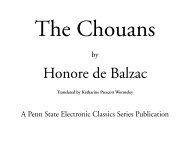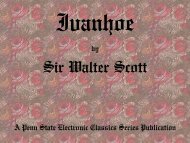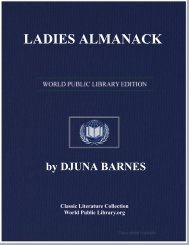THE GOD OF THE WITCHES - World eBook Library - World Public ...
THE GOD OF THE WITCHES - World eBook Library - World Public ...
THE GOD OF THE WITCHES - World eBook Library - World Public ...
You also want an ePaper? Increase the reach of your titles
YUMPU automatically turns print PDFs into web optimized ePapers that Google loves.
papyrus of the XXIInd dynasty, about the tenth century B.C., a woman is depicted in the act of praying to her god<br />
(plate vi). But the description given by Isobel Gowdie in 1662 of a ceremony performed by herself and her coven<br />
would apply to the scene on the papyrus, "When we had learned all these words from the Devil, we all fell down<br />
upon our knees, with our hair down over our shoulders and eyes, and our hands lifted up, and our eyes<br />
steadfastly fixed upon the Devil, and said the foresaid words thrice over to the Devil".[35] The flowing hair and<br />
the uplifted hands and eyes, as well as the horned god, are alike in both Egypt and Scotland. No-one would<br />
hesitate to say that the Egyptian lady was engaged in the worship of her god, who was symbolised to her in the<br />
figure of a goat, yet most people of the present day are horrified to think that less than three centuries ago a<br />
similar worship of a "heathen" god was still practised in the British Isles.<br />
The ritual masking of the Incarnate God or his priest is found in many places after the Palaeolithic period.<br />
Beside the dancing god there are the little masked and horned figures. I have already called attention to these in<br />
their geographical and chronological order, but it is important to note that figures of maskers and the masks<br />
themselves still survive. On the so-called Hunting Palette of predynastic Egypt[36] the figure of a man disguised<br />
as a jackal and playing on a flute suggests the black-dog disguise of the European Devil. A jackal mask<br />
belonging to the XXVIth dynasty, about the seventh century B.C., is made of pottery and is intended to be worn<br />
over the head (plate vii. 1). The method of wearing it is shown in the procession of priests at Denderah, where<br />
the masked priest has to be led by one of his fellows (plate III. 2). This jackal-mask should be compared with the<br />
"Dorset Ooser" (plate VII. 2), which was stolen from its Dorsetshire owners within the last thirty years. The Ooser<br />
was of painted wood, and, like the Egyptian example, was worn over the head, the wearer being at the same<br />
time wrapped in an oxskin. The combination of the horned mask and the animal's skin show too close a<br />
resemblance to the Palaeolithic prototype to be accidental. In the Ooser we have the last remains of that most<br />
ancient of all recorded religions, the worship of the Horned God.<br />
The name of the great Pagan deity varied according to the country in which the cult was followed. In the Near<br />
East the names were recorded from very early times; the name of the Indian deity cannot yet be read, but the<br />
traditional name still survives; in Greece and in Crete the record is later than in Egypt and Babylonia. In Western<br />
Europe, however, it was not till the Roman domination that any written records were made; therefore it is only by<br />
tradition and an occasional Roman inscription that the names of the homed god are known to us. The great<br />
Gaulish god was called by the Romans Cernunnos, which in English parlance was Herne, or more colloquially<br />
"Old Hornie". In Northern Europe the ancient Neck or Nick, meaning a spirit, had such hold on the affections of<br />
the people that the Church was forced to accept him, and he was canonised as St. Nicholas, who in Cornwall<br />
still retains his horns. Our Puck is the Welsh Boucca, which derives either directly from the Slavic Bog "God" or<br />
from the same root. The word Bog is a good example of the fall of the High God to a lower estate, for it<br />
becomes our own Bogey and the Scotch Bogle, both being diminutives of the original word connoting a small<br />
and therefore evil god.<br />
Many of the names of the Devils appear to be diminutives. Thus among the group of Alsatian witches tried<br />
between 1585 and 1630,[37] the names for the Devil (i.e. the God) were Hämmerlin, Peterlin, and Kochlöffel.<br />
The first of these may mean a yellowhammer, always regarded as the Devil's bird, but as the name is also given<br />
as Hammer it is suggestive of a diminutive of an epithet of Thor; Peterlin may be the Christianised form of a<br />
local deity; for Kochlöffel (Cooking-spoon) I can offer no explanation except that it may be a mispronunciation of<br />
a traditional name. According to de Lancre the name of the Basque god was Jauna or Janicot.[38] The latter he<br />
regarded as a diminutive and says that it means "petit Jean", and was applied by the witches of the Basses<br />
Pyrénées to Christ; a man-witch at Orleans also spoke of the host as "un beau Janicot."[29] It may however not<br />
be a diminutive, but a form of Jauna with the ending Cot "God", as in the Northern Irmincot. In modern times the<br />
god, who has now degenerated into a sprite, is known by the Basques as Basa-jaun, the equivalent of Homme<br />
de Bouc, Goat-man[40] which brings the whole of the early religion of the Basques into connection with the<br />
Horned God. De Lancre notes that the witches, when "in the hands of Justice" used the name Barrabon[41] to<br />
signify either their own or the Christian God, Barrabon[42] being also the name of a witch-god in Belgium.<br />
A peculiar name, which occurs both in Great Britain and France is Simon; it was used for either the<br />
Grandmaster or for the familiars which were also called devils. It is possibly a diminutive like the Mamilion of<br />
12















